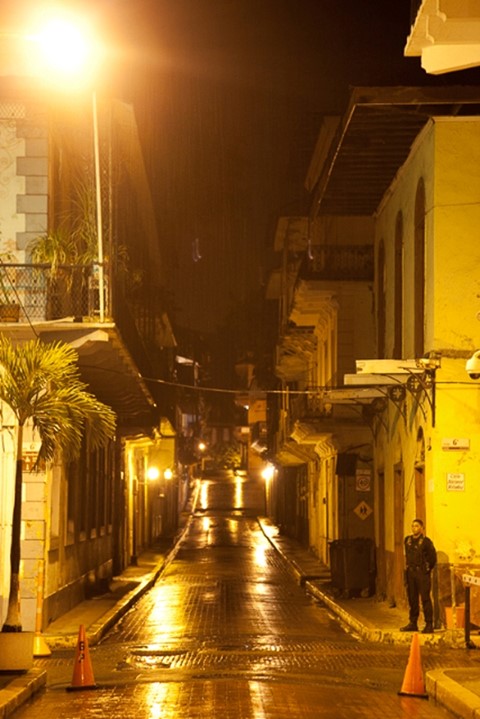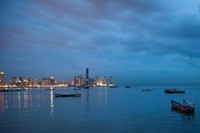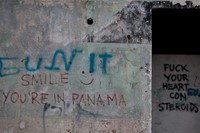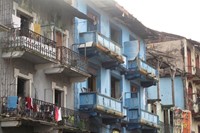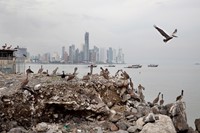The old city of Casco Viejo sits on a peninsula jutting out of the Bay of Panama and is approximately half the size of New York’s East Village. It is the home of four churches and two cathedrals. I was seeking the holy grail of Panama...
The old city of Casco Viejo sits on a peninsula jutting out of the Bay of Panama and is approximately half the size of New York’s East Village. It is the home of four churches and two cathedrals. I was seeking the holy grail of Panama much like the murderous bucaneer Henry Morgan had done nearly 350 years ago. I knew it to be in the Iglesia San Jose, but even with a map, I had mistakenly interrupted a couple of weddings before pushing open the proper thick arched doors to end my quest.
A heavy-set woman dressed in a simple black dress, knelt at a pew and counted the white beads of her rosary as their clicking echoed off the walls. A warm glow reflected off her face as her eyes pleaded to the intricate golden altar that stood before her, from floor to ceiling.
When Morgan pillaged Panama in 1671, the capital was considered the wealthiest city of new Spain, and the altar its most coveted treasure. Anticipating the pirate’s arrival, the Spanish had stashed almost all of the town’s riches out of reach on a ship in the Gulf of Panama. Too bulky and heavy to be moved surreptitiously, an ingenious priest had the Altar de Oro painted black like mahogany to avoid detection. Morgan, rabid at not having found sufficient booty, brutally tortured and raped many residents in an attempt to extract its whereabouts, yet no one ever gave it up. As a result the altar kept its cloak of secrecy.
Walking through Casco Viejo one feels like a time traveller. Declared a world heritage site by UNESCO, the architecture is a testament to its diverse rulers and settlers, from the Spanish and the French (and also a tragicomic attempt by the Scots) to the English and the Colombians, but also to the three fires in the 18th century that all but destroyed it. Wandering through the narrow streets with its embassies, the presidential palace, renovated mansions pressing against dilapidated shells with weeds or even trees growing out of their crumbling brickwork, or pastel coloured houses splashed with graffiti, I crossed an imaginary boundary into El Chorillo before being waved back by the “tourist police.”
El Chorillo is the barrio to the north of Casco Viejo linking it to the mainland. It is one of the more important districts of the city historically, but also the source of almost all of modern day organized crime. An impoverished collection of wooden shacks, makeshift cinder block houses with rusting corrugated roofs, it caught national attention as home to boxing legend Roberto Duran, but has been ignored by all the dictatorships and governments of the last eighty years. An exception came from the dictator Torrijos who rose from the slums to the presidency in the Seventies, and ensured that Chorillo was well-kept and that the poor were fed. Unfortunately, he was killed in a mysterious plane crash (CIA anyone?), and the dream turned into the Noriega nightmare.
Noriega, a former CIA operative, set up his National Defense Force headquarters in Chorillo, and from there ran all his drug trafficking operations, executions, and money laundering. As a result, gangs formed to carry out his activities and Chorillo spiralled downwards until George Bush Sr. implemented operation Just Cause to remove the rogue leader, whom the U.S. had handpicked to replace the pro-Castro Torrijos.
On the night of December 20, 1989, American helicopters dropped 442 bombs in the first ten hours of the invasion in Chorillo. Over 4,000 homes were burned to the ground and as many as 5,000 civilians were killed during the invasion or from the ensuing riots. Though the latter figure is an approximation, what is known is that whatever the number is, it would have been greatly reduced had the firemen been allowed to intervene by the US army.
Now a highly dangerous area similar to the favellas of Rio, it is a stark reminder of the wealth gap that exists between Chorillo and Casco Viejo as well as within the whole of Panama. Due to the presence of the Presidential Palace and the overall touristic potential, there seem to be more policemen and security forces on the streets of Casco Viejo than residents.
With these conundrums ruminating, I grabbed a quick bite at a tapas restaurant and made my way back to the hotel. The narrow streets were alive with Panamanians appearing in and out of the shadows, created by bare yellow bulbs hanging from cracked ceilings, or ghosting out of the smoke from parrillas grilling meats. As loud salsa played through boom boxes, they were hanging out on corners or taking part in dubious exchanges of small packages. It felt timeless, as though I was walking through a portal in the Forties or Sixties, occasionally being stared at suspiciously through the open door of someone’s breathlessly humid living room illuminated by late night TV.
Victoria, a writer and my travelling companion, suggested that there were five boys “marauding.” A minute later, a barrage of gunfire erupted at the end of the block. The exchange was so long that at first we looked up for fireworks. People ran, panicked, and fled from the scene, but strangely there were no signs of the police. Half an hour passed before a pickup truck – sirens blaring – rushed by me with two wounded tourists caught in the crossfire of two rival gangs. They had been shot in the back and arms, and two teenagers, aged 17 and 16 years old, had been arrested, shifting that imaginary boundary from El Chorillo to outside my hotel. This had been my first day. “Welcome to Panama!”
Text by Doug Bruce
